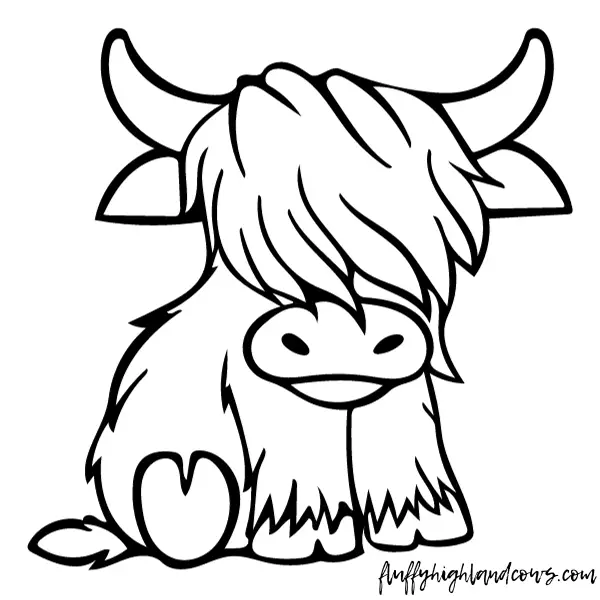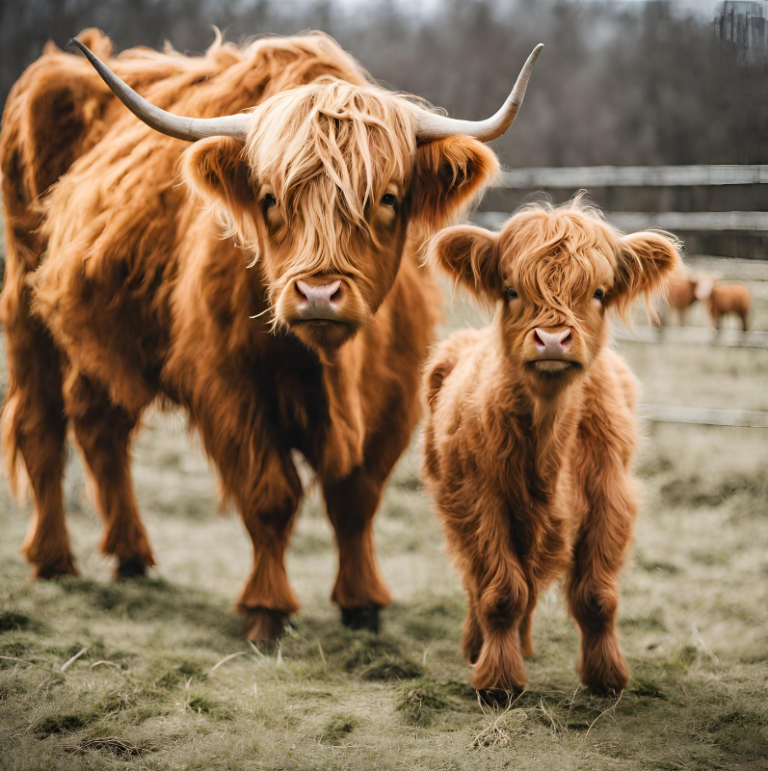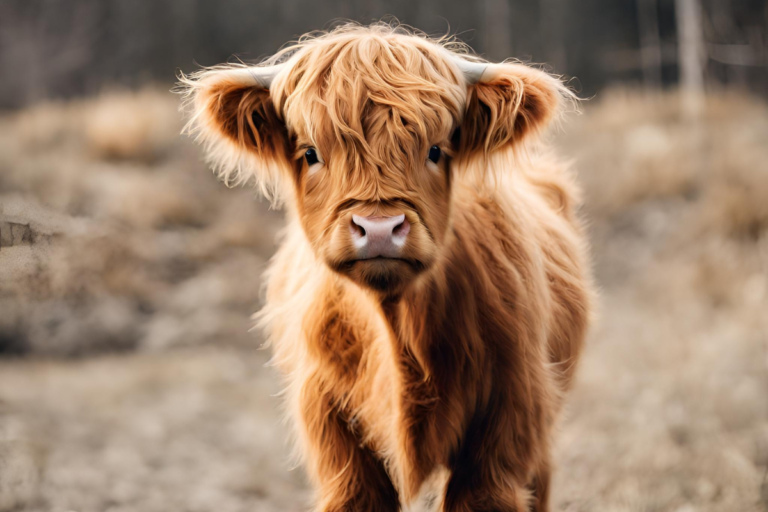Getting Started with Highland Cattle Farming
Welcome to the exciting world of Highland cattle farming, where the charm of these rugged, shaggy creatures meets the satisfaction of running a successful livestock operation. If you’re drawn to the idea of raising these iconic Scottish cattle, you’re in for a rewarding adventure.
Highland cattle, with their distinctive long horns and shaggy coats, hold a special place in the hearts of many farmers and enthusiasts. Beyond their captivating appearance, they bring a host of benefits to your farm, from hardiness and adaptability to producing high-quality beef and even dairy products.
In this guide, we’ll walk you through a range of practical tips and insights that will help you thrive in the world of Highland cattle farming. Whether you’re just starting out or looking to enhance your existing knowledge, this friendly yet authoritative resource will equip you with the knowledge and skills you need for success. So, let’s embark on this journey together and discover the joys of Highland cattle farming.
Getting Started with Highland Cattle Farming
Selecting the Right Location
Finding the ideal location for your Highland cattle farm is the first crucial step on your journey to success. The right environment can make all the difference in the well-being and productivity of your cattle. Here’s what you need to consider:
Suitable Climate and Terrain
Highland cattle are known for their resilience, but they still thrive in specific conditions. Look for a location with a climate that suits their natural hardiness. Highland cattle can endure colder temperatures, but they also need protection from extreme heat. Moreover, consider the terrain; they prefer hilly or rugged areas, which mimic their native Scottish habitat.
Adequate Pasture and Forage Availability
These cattle are excellent foragers and graze on a variety of plants. Ensure that your farm has ample pastureland with a diverse range of vegetation to support their dietary needs.
Acquiring Highland Cattle
The quality and health of your Highland cattle are pivotal to the success of your farm. Here’s what you should keep in mind:
Choosing Reputable Breeders or Sources
Seek out reputable breeders or sources with a history of breeding healthy and well-maintained Highland cattle. Networking with experienced Highland cattle farmers or joining breed associations can provide valuable insights and connections.
Assessing the Health and Quality of Animals
When acquiring Highland cattle, carefully inspect each animal for signs of health and vitality. Check for clear eyes, a shiny coat, and good body condition. Also, inquire about the animal’s medical history and vaccination status.
Starting your Highland cattle farming venture with a well-thought-out location and healthy stock sets a strong foundation for a successful journey. So, let’s continue on this path, and we’ll delve into housing, feeding, and other essential aspects of Highland cattle farming in the upcoming sections.
Housing and Fencing
Building a Shelter
Creating suitable housing and fencing for your Highland cattle is essential to ensure their well-being and safety. Here’s what you need to know about providing them with proper shelter:
Shelter Design and Considerations: Highland cattle are known for their ability to withstand harsh weather conditions, but they still require shelter from extreme cold, rain, and wind. When designing their shelter, consider the following:
- Adequate Space: Ensure there is enough space for all your cattle to comfortably rest and move around inside the shelter.
- Ventilation: Proper ventilation is crucial to prevent moisture buildup and maintain air quality. Adequate ventilation prevents respiratory issues and keeps the shelter comfortable.
- Protection from Elements: Make sure the shelter has a solid roof and walls to provide protection from rain, snow, and strong winds.
- Drainage: Proper drainage is essential to avoid puddles and moisture buildup inside the shelter.
Fencing Requirements
Highland cattle are known for their inquisitive and sometimes adventurous nature. To keep them safe and secure, you’ll need to invest in the right fencing. Here are some fencing considerations:
Types of Fencing Suitable for Highland Cattle: Highland cattle are strong and can sometimes test the boundaries of their enclosures. Consider these fencing options:
- High Tensile Electric Fencing: This is effective in containing Highland cattle, as they are usually respectful of electric boundaries.
- Wooden or Steel Fencing: Sturdy wooden or steel fences can also work well, but they should be tall and well-constructed to prevent cattle from leaning on or damaging them.
- Regular Maintenance: Whichever fencing type you choose, regular maintenance is essential to address wear and tear and prevent escapes.
Ensuring that your Highland cattle have a comfortable and secure place to call home is crucial for their well-being and your farming success. In the next section, we’ll explore nutrition and feeding requirements to keep your cattle healthy and thriving.
Nutrition and Feeding
Proper nutrition is key to maintaining the health and productivity of your Highland cattle. These rugged animals are excellent foragers, but to ensure they thrive on your farm, it’s essential to manage their nutrition effectively. Here’s what you need to know:
Pasture Management
Highland cattle are known for their ability to graze on various plants and thrive in a range of landscapes. To make the most of their natural foraging abilities, consider the following pasture management strategies:
Grazing Strategies: Implement rotational grazing to maximize pasture use and prevent overgrazing. Highland cattle are excellent at browsing, and this approach ensures they have access to fresh, nutritious forage.
Diverse Vegetation: Encourage diverse plant species in your pastures. Highland cattle have a varied diet, and providing a mix of grasses and forbs can improve their nutrition.
Fencing: Properly divide pastures with well-maintained fencing to manage grazing areas effectively.
Supplemental Feeding
While Highland cattle are proficient grazers, there are times when supplementary feeding may be necessary, such as during winter or when pasture quality is low. Here are some considerations:
Types of Supplementary Feed: Depending on your specific needs, you may provide hay, silage, or grain-based supplements. Consult with a nutritionist or veterinarian to determine the best feed for your cattle.
Feeding Schedule: Establish a regular feeding schedule and provide access to clean, fresh water at all times.
Monitor Body Condition: Regularly assess the body condition of your cattle to ensure they are receiving adequate nutrition. Adjust their diet as needed.
Watering Needs
Highland cattle, like all livestock, require access to clean and fresh water. Ensure they have a reliable water source, especially during hot weather when hydration is crucial. Regularly check waterers and troughs to prevent contamination.
Managing the nutrition and feeding of your Highland cattle is essential for their health and productivity. In the following section, we’ll delve into health and veterinary care, which is another critical aspect of successful Highland cattle farming.
Health and Veterinary Care
Maintaining the health of your Highland cattle is paramount to their well-being and your farming success. These rugged animals are known for their hardiness, but they still require proper care and attention to stay healthy. Here’s what you need to know:
Regular Health Check-ups
Vaccination Schedules: Work with a veterinarian to establish a vaccination schedule tailored to your Highland cattle’s specific needs. Vaccinations protect your herd from common diseases such as clostridial infections and respiratory illnesses.
Parasite Control: Implement a regular deworming program to control internal parasites. Monitoring fecal samples can help you determine the effectiveness of your deworming efforts.
Handling Emergencies
Common Health Issues in Highland Cattle: Familiarize yourself with common health issues that Highland cattle may face, including respiratory infections, hoof problems, and calving complications.
Emergency Response Procedures: Have a plan in place for addressing emergencies. This should include knowing how to handle injuries, when to call a veterinarian, and having necessary supplies on hand.
Isolation: Isolate sick or injured cattle to prevent the spread of disease and provide them with individualized care.
Remember that preventive measures are often more effective and less costly than treating illnesses after they occur. Regular check-ups and proactive health management are essential to keeping your Highland cattle healthy and thriving.
In the next section, we’ll explore breeding and reproduction management to help you grow and expand your Highland cattle herd.
Breeding and Reproduction
Breeding and reproduction management play a pivotal role in the growth and sustainability of your Highland cattle herd. Whether you’re looking to expand your herd or maintain its quality, here are some key considerations:
Breeding Management
Selecting Breeding Stock: Carefully choose breeding stock with desirable traits, such as good conformation, strong genetics, and excellent temperament. Assess their pedigree and lineage to ensure you’re enhancing the quality of your herd.
Understanding Estrus Cycles: Highland cattle have distinct estrus cycles, and recognizing when your cows are in heat is crucial for successful breeding. Observation and record-keeping can help you pinpoint the right time for mating.
Bull Selection: If you plan to keep a bull for natural mating, select one with the characteristics you want to pass on to your calves. Ensure the bull is healthy and has undergone fertility testing.
Calving and Calf Care
Preparing for Calving Season: Be well-prepared for calving season. Ensure that you have clean, safe calving facilities and that you’re available to assist with any complications if needed.
Calf Health and Care: After calving, monitor the health and growth of your calves closely. Provide them with proper nutrition, vaccinations, and care to ensure they develop into strong, healthy Highland cattle.
Weaning: Decide on the appropriate time to wean calves based on their growth and development. This is a critical phase in their early life.
Proper breeding and reproduction management are essential for the long-term success of your Highland cattle farm. With careful planning and attention to these factors, you can maintain and improve the quality of your herd.
In the upcoming section, we’ll discuss the importance of record-keeping and documentation in Highland cattle farming, which can help you make informed decisions and track the progress of your herd.
Record Keeping and Documentation
Maintaining comprehensive records and documentation is a fundamental aspect of effective Highland cattle farming. Proper record-keeping not only helps you stay organized but also provides valuable insights into the health, productivity, and performance of your herd. Here’s what you need to know:
Importance of Keeping Farm Records
Data-driven Decision Making: Records serve as a basis for making informed decisions about breeding, feeding, and health management. They allow you to track trends and identify areas for improvement.
Compliance: Accurate records can help you demonstrate compliance with regulatory requirements and animal welfare standards. This is crucial for maintaining the reputation and legality of your farm.
Financial Management: Record-keeping aids in financial planning, budgeting, and tax reporting. It provides transparency into the financial aspects of your operation.
Tracking Health, Breeding, and Performance Data
Health Records: Maintain detailed health records for each animal, including vaccination schedules, deworming, and any treatments or illnesses. This helps you detect patterns and address health issues promptly.
Breeding Records: Keep records of breeding dates, sires used, and calving outcomes. This information helps you assess the success of your breeding program and make informed decisions about future breeding.
Performance Data: Record growth rates, weight gain, and other performance metrics for your cattle. This data is valuable for evaluating the quality of your herd and optimizing feeding strategies.
Inventory Management: Keep an inventory of your cattle, including birth dates, identification numbers, and any changes in ownership or disposition.
Digital Tools and Software
Consider using digital tools or farm management software to streamline your record-keeping processes. These tools can help you organize and analyze data more efficiently, reducing the risk of errors and simplifying reporting.
By maintaining accurate and up-to-date records, you can better manage your Highland cattle farm, improve herd performance, and ensure compliance with industry standards and regulations.
In the following section, we’ll explore marketing and sales strategies for Highland cattle products, helping you maximize the returns on your farming investment.
Marketing and Sales
Marketing and sales strategies are essential components of a successful Highland cattle farming operation. Whether you’re selling cattle, beef, or other related products, effective marketing can help you reach your target audience and maximize returns on your investment. Here’s what you need to consider:
Marketing Highland Cattle Products
Know Your Audience: Understand your target market. Are you selling breeding stock, beef, or other products? Tailor your marketing efforts to the needs and preferences of your audience.
Branding: Develop a strong brand identity for your Highland cattle farm. This can include a memorable farm name, logo, and a compelling story that connects with customers.
Online Presence: Create a professional website and use social media platforms to showcase your Highland cattle and products. Share high-quality photos, videos, and informative content to engage potential buyers.
Networking: Build relationships within the Highland cattle community and the broader livestock industry. Attend cattle shows, fairs, and agricultural events to network with potential buyers and fellow farmers.
Selling Strategies and Channels
Direct Sales: Consider selling your Highland cattle directly to other farmers, ranchers, or enthusiasts. This approach allows you to retain more control over pricing and customer relationships.
Auctions and Sales Events: Participate in livestock auctions and sales events specific to Highland cattle. These events attract a targeted audience looking for quality cattle.
Local Markets: Explore opportunities to sell Highland beef and related products at local farmers’ markets, specialty butcher shops, or restaurants that prioritize locally sourced meats.
Online Sales: Utilize online platforms, such as livestock classified websites or social media, to reach a broader audience. Ensure that you comply with any legal requirements for online livestock sales.
Building Relationships with Buyers
Customer Service: Provide excellent customer service to build trust and repeat business. Be responsive to inquiries, provide accurate information, and fulfill commitments.
Transparency: Maintain transparency in your dealings with customers. Provide information about the health, genetics, and history of your cattle to instill confidence in buyers.
After-Sales Support: Offer after-sales support and guidance to buyers, especially if they are new to Highland cattle farming. Share your knowledge and expertise to help them succeed.
Effective marketing and sales efforts can help you showcase the value of your Highland cattle and products, attract potential buyers, and build a strong reputation in the farming community. With these strategies in place, you can optimize the profitability of your Highland cattle farming venture.
Legal and Regulatory Compliance
Highland cattle farming, like any agricultural endeavor, is subject to various legal and regulatory requirements. Compliance with these rules and standards is essential for the sustainability of your farm and the welfare of your cattle. Here’s what you need to know:
Understanding Local and National Regulations
Zoning and Land Use: Ensure that your farm complies with local zoning regulations and land use ordinances. Some areas have specific rules regarding the keeping of livestock, including Highland cattle.
Environmental Regulations: Be aware of environmental regulations related to farming, such as waste management, water usage, and conservation practices. Implement measures to minimize the environmental impact of your operation.
Livestock Identification: Depending on your location, you may be required to identify and tag your Highland cattle for traceability and disease control purposes. Understand the specific identification requirements in your area.
Compliance with Animal Welfare Standards
Animal Welfare Laws: Familiarize yourself with animal welfare laws and standards that apply to cattle farming in your region. These laws may govern aspects like animal housing, care, and transportation.
Humane Handling: Ensure that you and your farm staff handle Highland cattle in a humane and ethical manner. This includes safe and low-stress handling practices during transportation, health checks, and other activities.
Veterinary Care: Comply with veterinary care requirements, including regular check-ups, vaccinations, and treatment of illnesses or injuries. Keep detailed health records to demonstrate compliance.
Licensing and Permits
Farm Licenses: Obtain any necessary licenses or permits required for running a cattle farm in your area. This may include business licenses or agricultural permits.
Export and Transport Permits: If you plan to export Highland cattle or transport them across state or national borders, be aware of the permitting and health certification requirements.
Regularly check with local agricultural authorities and agricultural extension services to stay up-to-date on any changes in regulations or requirements that may affect your Highland cattle farm.
In conclusion, adhering to legal and regulatory standards is not only a legal obligation but also essential for the ethical and responsible management of your Highland cattle farm. It ensures the welfare of your cattle and contributes to the overall success of your operation.
Recapping Our Guide to Highland Cattle Farming
Congratulations! You’ve now explored a comprehensive guide to Highland cattle farming, from selecting the right location and acquiring healthy stock to managing nutrition, health, and compliance with regulations. As you embark on or continue your journey in Highland cattle farming, remember these key takeaways:
- Passion and Commitment: Highland cattle farming requires dedication and a genuine love for these majestic animals. Your passion will drive your success.
- Knowledge is Power: Continuously educate yourself about Highland cattle, farming practices, and the latest industry trends. Stay connected with fellow farmers and resources to enhance your knowledge.
- Holistic Approach: View your farm as a holistic system. Balance nutrition, health, breeding, and management practices to maintain a healthy and thriving herd.
- Records Matter: Comprehensive record-keeping is not just paperwork; it’s a tool for making informed decisions and tracking the progress of your farm.
- Ethical Farming: Treat your cattle with respect and prioritize their welfare. Ethical and humane practices are not just legally required but also morally essential.
- Marketing Savvy: Effective marketing and sales strategies are vital for connecting with potential buyers and ensuring the profitability of your operation.
- Regulatory Compliance: Always adhere to local, national, and animal welfare regulations. Compliance is not just a legal obligation; it’s a foundation for responsible farming.
Your Highland cattle farming adventure is a journey of learning, growth, and rewards. Embrace the challenges and celebrate the successes, and your journey will be a fulfilling and prosperous one. Best of luck with your Highland cattle farming endeavor!







